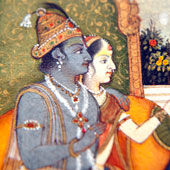Miniature Painting
Rajasthan is the land of great culture, tradition, art and crafts. The artistic and craft culture of Rajasthan was largely influenced by the Mughal Rulers. These rulers along with them brought several art and crafts which with little change in style and form slowly emerged as a native practice of Rajasthan. Miniature paintings are one such art form that was introduced by Mughals but later developed its own distinctive style fitting to the culture and tradition of Rajasthan. The art flourished under the patronage of Mughal and Hindu rulers from Deccan, Rajasthan etc. Many important painting/art schools came into being and flourished in different parts of the region. These can be broadly divided into Mughal, Rajput/Rajasthan, and Deccan schools. The Rajput school began to absorb elements of the Mughal style due to the growing alliances between the Rajput kingdoms and Mughals. These paintings involved/ incorporated elements of Hindu, Persian, and European styles/stories.
In Rajasthan there are four main schools for miniature paintings: The Mewar school uses bright colors to paint religious motifs and Hindu mythological characters, the Amber-Jaipur school uses muted colors to depict court scenes, landscapes, and nature, the Marwar school depicts accentuated facial features like large, curving eyes, and rolling clouds and a common theme including Bani-Thani, the love of Sawant Singh who ruled Kishangarh, and the Bundi-Kota school depicts landscapes and hunting scenes.
In Jaipur artists, mainly from the Brahmin family work on a variety of materials from handmade paper and boards of wood to cloth and marble. Most of them still use natural colors derived from insects, shells, minerals, vegetable matter as well as silver and gold, and artists also use brushes made out of squirrel hair. Traditionally the artist used vellum in place of paper. Before this paintings were made on special surfaces made from bamboo, jute, palm leaf, and cotton.







